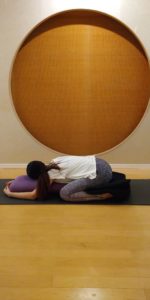
Photos (c) by Nao Onishi, Modeling by Kanako Fukui
by Leza
Self-love is on my mind this February. Valentine’s Day reminds us of the power of sharing love, gratitude, and connection. What better way to give yourself the gift of self-love than a few minutes in Supported Child’s Pose (Salamba Balasana) every day? The pose is a release for the spine, as it gently stretches the lower back and releases tension in the shoulders and neck. It also stretches the hips. In addition, it is a very calming pose because forward folds are inward focused. So, it is an excellent way to reduce stress, calm the nervous system, and quiet the mind.
I find this pose helps me to become more centered and attuned to my inner voice. I like to imagine an umbilical cord stretching from my belly all the way through the floor, to the very center of the earth. This deep connection to Mother Gaia reminds me I am not alone and fills me with compassion. We are all children of Mother Earth. Remembering this and offering love and appreciation to our Earth Mother is a powerful practice of gratitude and humility.
I recommend practicing this pose whenever you need some time to go within, release tension, re-set, and remember to love yourself, this precious planet, and all beings who inhabit it.
Time: 5-10 minutes. If resting on one cheek, make sure to stay in the pose for an equal amount of time on each cheek.
Caution: Those with chronic back problems and severe neck issues should avoid this pose.
Setting Up
To set up for the pose, you’ll need the following: yoga mat, 1 bolster, 2-3 blankets as needed. For a variation, one sandbag.
Start by spreading a yoga mat on the floor. Place a yoga bolster or stack of blankets folded in long rectangles in the center of the mat, vertically. If kneeling on the mat is uncomfortable, add a folded blanket to pad the knees and tops of the feet.
To Come into the Pose
Kneel in the center of your mat, either on the mat or on the folded blanket you are using to support your knees, and sit back on your heels. Then open your knees as wide as is comfortable and slide the bolster between your knees but not under your pelvis. Do not sit on or “ride” the bolster.
As you inhale, lengthen your spine. As you exhale, fold yourself forward over the props, bringing your torso and head down onto the bolster. Bring your arms forward, holding on to the support if you like. Make sure your neck is long and shoulders are soft.
You can do this pose either by resting the forehead on the bolster or resting on one cheek, choosing whichever is most comfortable for you. If you are resting on one cheek, make sure to change to the other cheek halfway through the pose.
Practicing the Pose
Elongate the back of your neck, allowing the forehead or cheek to rest on the props. Invite your shoulders to release, then your lower back. Take several slow, deep breaths, melting into the support. Sense all the places you feel your body making contact with the props and the ground, and allow yourself to settle. Turn your attention inward and focus on your breath. Greet the sensations in your back body, groins, inner thighs, and entire body with an open mind, observing without judgment. If emotions arise, observe them and the changing sensations in loving awareness. If you feel any pain or discomfort, gently come out of the pose.
You can also try releasing tension, stress, anxiety, worry, and exhaustion on the exhalation and cultivating peace, self-love, and comfort on the inhalation. In quieter holds, anchor your awareness in the sensations in your body by following the breath as it moves in and out, finding stillness as you open and expand into the pose.
Variations
If your hips are lifted away from the heels and require additional support, slide a folded-up blanket under the buttocks (as shown in photo).

If your feet are uncomfortable, try folding a small towel under the tops of the feet for support. You could also try supporting your knees on a folded blanket or even a stack of folded blankets and then hanging your feet off the back of the blanket on which you are kneeling rather than having the tops of the feet pressed flat on the blanket.
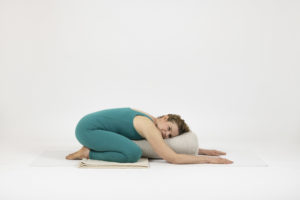
For a deeper sense of grounding, place a light sandbag on your lower back.
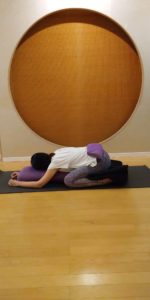
If bending onto the bolster isn’t comfortable (or possible), you may place blocks under the bolster for height, as shown in this photo. Make sure they are stable and secure.
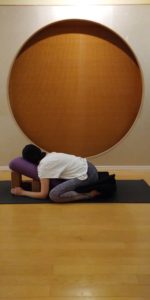
For people who cannot get up and down from the floor or who don’t have a good floor to practice on, this pose may also be done using two chairs. Place the two chairs close together and facing each other. Make sure they are securely on a yoga mat so they do not slide.
Sitting on one of the chairs, place a bolster or rolled-up blanket on the chair in front of you. Draw the prop up between your legs. Then fold forward from your hip joints to bring your torso and head forward onto the prop.
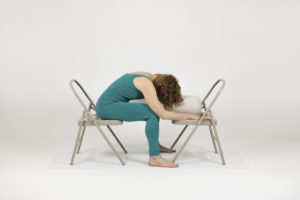
For a deeper sense of calm and quiet, cover yourself with a blanket, like a cap. Trauma-sensitive practitioners might use a weighted blanket.
You can read more about Leza’s writing at www.lezalowitz.com and about her yoga studio and classes at www.sunandmoon.jp.
• Follow Yoga for Healthy Aging on Facebook and follow Nina on Instagram • Order Yoga for Times of Change here and purchase the companion videos here • Order Yoga for Healthy Aging: A Guide to Lifelong Well-Being here.


Leave A Comment